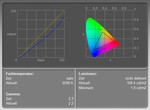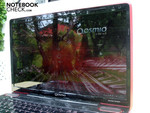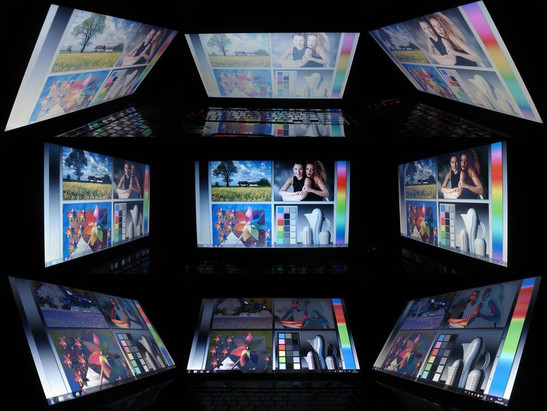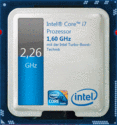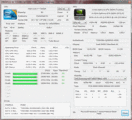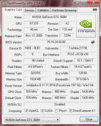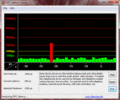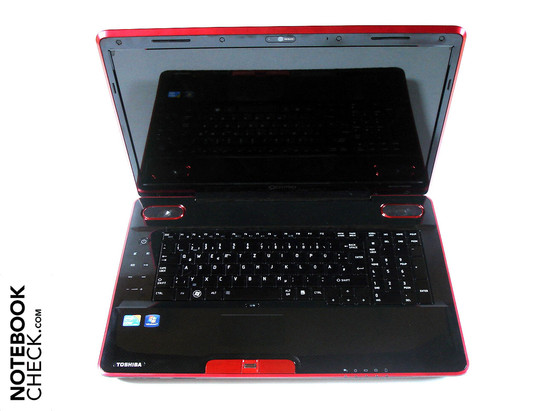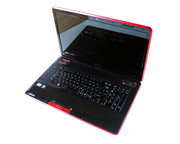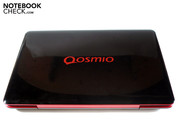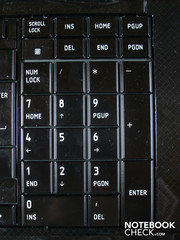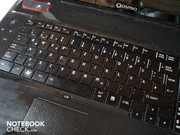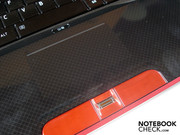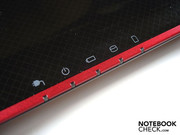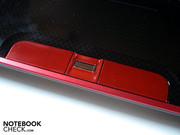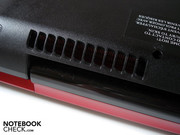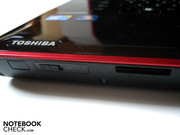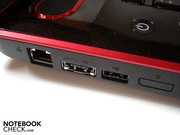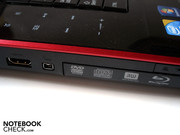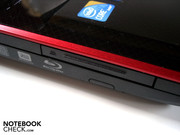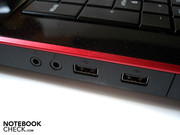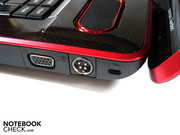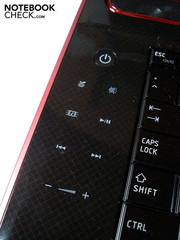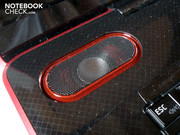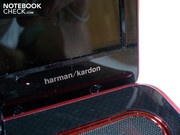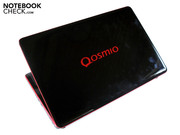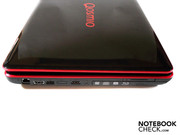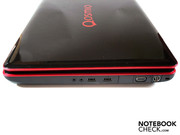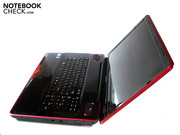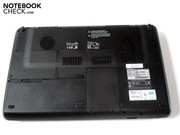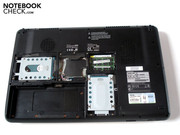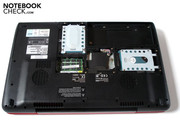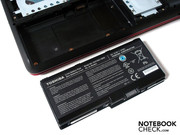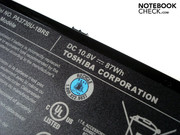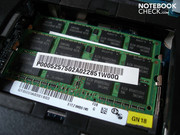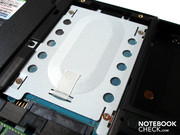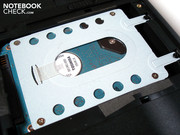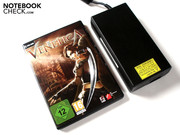Review Toshiba Qosmio X500-121 Notebook
At the moment only three models of the Qosmio X500-series are more or less available in stores. The model that we have tested, the Qosmio X500-121 has a recommended price of 1649 Euros (street prices are circa 1600 Euro) and is equipped with a spacious eight GB of RAM (2x 4096 MB DDR3-8500) as well as two hard drives with a total capacity of 640 GB (2x 320 GB, 5400 rpm).
Moving a rung down the model ladder puts 100 Euro in your pocket; the Qosmio X500-12D lowers the available RAM to a still respectable 6 GB (1x 4096 MB + 1x 2048 MB) and the hard drive capacity moves down to 500 GB. A notch below this is the Qosmio X500-111 with 4GB of RAM and a 320 GB hard drive, though we would no longer recommend this model since the GeForce GTS 250M is inferior to the GeForce GTS 360M in the newer models.
Common to all models is the quad-core processor from Intel, the Core i7-720QM with a clock speed of 1.6 to 2.8 GHz. Adding to all of this, Toshiba chose to outfit the X500 series with a Blu-Ray drive that can burn Blu-Rays in addition to DVDs. Also of note is the 18.4-inch display with a resolution of 1680 x 945 pixels. In every instance the 64-bit version of Windows 7 Home Premium is the default OS choice. The notebook comes with a 24-month warranty which includes international Bring-In-Service as well as an on-site pickup service for Germany and Austria.
As we tested an identical Toshiba Qosmio X500 a few months ago, we will not be diving into detail about the chassis, equipment and input devices. For those interested in reading about these points in more, check out our original review of the Toshiba Qosmio X500-10V.
Display
The 18.4-inch display rendered in 16:9 format has a rather unusual native resolution of 1680 x 945. Surprisingly, this resolution is supported by the majority of current games and provides a sufficiently large work surface upon which two windows can be opened and used at the same time.
| |||||||||||||||||||||||||
Brightness Distribution: 85 %
Contrast: 140:1 (Black: 1.31 cd/m²)
In comparison to the Qosmio X500-10V, Toshiba uses a different panel of the type SEC324B in the Qosmio X500-121. This panel sets itself apart from the previous model with an improved average brightness (168.5 to 148.4 cd/m²) and a similar illumination value (85 to 80%). With numbers like these the "old" display can be put safely to rest with values sub-par to its replacement.
We will start with the black values, which range from a very good 0.23 cd/m² to an average 1.31 cd/m². Dark areas which are mostly present in games and film do not appear as a dark black but are rather gray in appearance. The largest point of criticism is the disappointing contrast, which dropped from an excellent 710:1 to nothing more than 140:1. Color and brightness graduations are not particularly differentiable with values like these. To compound this problem the colors are generally lacking a certain naturalness and intensity; a lighter yellow tinge, especially when using Office applications, would have been more appealing to the eye. All in all the picture quality is neither worthy of a desktop replacement nor a notebook in the price range of 1600 Euro.
The display isn't exactly suited to outdoor use. The reflective display surface leads to strong reflections in situations where there is moderate sunlight; this makes the picture being displayed hard to recognize. In interior rooms where the notebook is positioned opposite or under windows distracting reflections are a certain possibility.
A final word on the viewing angle: though the picture stays relatively stable even at wide horizontal angles, vertically the color tone and illumination quickly changes. The limitations on the vertical viewing angle are very extensive, so much so that even when one has found an optimal seating position the viewable part of the display still drifts into gray shades.
Performance
In contrast to the graphics card, nothing has changed with respect to the processor. Intel's entry-level quad core Core i7-720QM still stands at the ready for the tasks on hand. The clock frequency of the 720QM isn't anything astonishing at 1.60 GHz, but the performance of the current Core-series is still convincing thanks to the efficiency of its design. With help from Turbo-Boost Technology the clock frequency is automatically raised up to 2.80 GHz when system demand from running applications could use the extra power. Contingencies for the Turbo-mode are that all four cores cannot be utilized at once and that the cooling system is not under undue stress.
A further feature of the Core i7-720M is the Hyperthreading-Technology. This technology supplements the four physical cores with four virtual cores so that the CPU is able to process up to eight physical threads at once. In applications optimized for parallel computation Hyperthreading can lead to a noticeable speed increase, though games will hardly profit from such technology. The maximum electrical consumption, at 45 Watts, isn't exactly low but there again the 774 million transistor chip with 1024 KB L2 cache and 6144 KB of L3 cache isn't exactly concerned with saving energy.
When it comes to the RAM, Toshiba upped the ante and outfitted the Qosmio X500-121 with a total of 8192 MB DDR3-RAM (1066 MHz) in the form of two 4096 MB modules. Thanks to the 64-bit variant of Windows 7 Home Premium the entire amount of RAM is available for use. This amount of RAM should not present a bottleneck even in years to come, as even the most demanding games currently out there do not require more than 4096 MB.
Toshiba fulfills an overdue update to the graphics system by upgrading the GeForce GTS 250M to the next-generation GeForce GTS 360M. Both graphics cards have 96 unified shaders as well as 1024 MB of video RAM of the GDDR5 variety. Thanks to the GDDR5-RAM the narrow 128-bit memory interface doesn't present the same performance bottleneck that DDR3-RAM did at high resolutions. The 40nm finishing process has also remained the same as has support for DirectX 10.1. Buyers will have to do without support for more advanced DirectX 11 graphics, as can be found on ATI's current cards as well as Nvidia's brand-new Fermi architecture (GeForce GTX 480M).
The uprated clock rates of the GeForce GTS 360M are certainly palpable compared to the GTS 250M. The core is clocked at 576 MHz instead of the old 450 MHz (+126 MHz), the memory at 1800 MHz instead of 1600 MHz (+200 MHz). The shader clock has been raised from 1080 to 1436 MHz (+356 MHz). Above all the increased clock rates should allow the GeForce GTS 360M to distance itself from the GTS 250M.
The Qosmio X500-121 had the 197.16 graphics drivers pre-installed. For the purposes of staying current we decided to use the newest version (257.21), which was just released before we reviewed the notebook.
Among other programs, we test the application performance with the 64-bit version of Cinebench R10. The Core i7-720QM scores 3748 points in the Single-core rendering test while the Core i7-620M, currently the fastest dual-core CPU, scores 4259 in the same test. In the multi-core rendering test the Core i7-720QM scores an excellent 10207 points over the Core i7-620's score of 9074 points.
| PCMark Vantage Result | 5441 points | |
Help | ||
For the graphics benchmarks we wanted to limit the comparisons with the competition to the most current 3DMark Vantage. With a good 5333 points, the GeForce GTS 360M sets itself apart from the Radeon HD 5650 (3450 points, Deviltech Fire DTX) and the GeForce GTS 250M (4371 points, Toshiba Qosmio X500-10V) and aligns itself more closely with the GeForce GTX 260M (5686 points, Alienware M15x) and the Radeon HD 5850 DDR3 (5691 points, Acer Aspire 8943G). Against the flagship Radeon HD 5870 (8044 points, Acer G73JH) and the GeForce GTX 480M (9277 points, Clevo D901F) the GeForce GTS 360M just can't hold its ground.
Note: apart from the Clevo Barebone are all notebooks powered by Core i7-720 processors.
| 3DMark 03 Standard | 26366 points | |
| 3DMark 05 Standard | 16879 points | |
| 3DMark 06 Standard Score | 9865 points | |
| 3DMark Vantage P Result | 5333 points | |
Help | ||
Two hard drives each with a capacity of 320 GB (5400 rpm) provide a considerable total capacity of 640 GB. The values recorded by HDTune prove that these HDDs have passable performance. The average transfer rates of 51.6 and 54.8 MB/s respectively are unimpressive, as good hard drives will put up numbers of 70 to 80 MB/s. Toshiba has divided the primary hard drive into two partitions of around 149 GB, while the secondary hard drive was left with one 298 GB partition. When the storage space at hand isn't sufficient, data can be stored externally with help from the Blu-Ray/DVD burner.
Conclusion: Performance
The performance in applications has us absolutely taken. Intel's Core i7-720QM, thanks to modern features like Hyperthreading and Turbo-Boost, offers not only a high degree of future proofing but also qualifies the quad-core machine to tackle anything that you can throw at it. The GeForce GTS 360M is not in any way inferior to the processor; when measured in 3DMarks the graphics card is roughly on the same level as the older GeForce GTX 260M. The only fault that we can find is that the equipment lacks the support for DirectX 11.
In order to best approximate the performance of the GeForce GTS 360M and minimize the influence from the CPU, we have carried out the gaming tests at very demanding settings at a resolution of 1920 x 1080. Here the GeForce GTS 360M is competing with a colleague from its own house (GeForce GTX 260M) and the opposition from ATI (Radeon HD 5730 & Radeon HD 5850 GDDR5). Unless otherwise specified, the indicated results are from the following notebooks: mySN XMG6, mySN MG7.c and the MSI GX640.
Modern Warfare 2
A frame rate of 34.0 fps makes Modern Warfare 2 playable at 1920 x 1080 with very high details and 4x anti-aliasing (AA). With a frame rate like this the GeForce GTS 360M ahead of the Radeon HD 5730 (25 fps) but behind the GeForce GTX 260M (40.0 fps) and the Radeon HD 5850 GDDR5 (46.7 fps).
| CoD Modern Warfare 2 | |||
| Resolution | Settings | Value | |
| 1920x1080 | all on/max vsync off, textures extra, 4xAA | 34 fps | |
| 1366x768 | all on/high vsync off, high textures, 4xAA | 53.1 fps | |
| 1024x768 | all on/med vsync off, normal textures, 2xAA | 61.3 fps | |
Bad Company 2
In Bad Company 2 the performance differences of the individual graphics cards are less noticeable. The GeForce GTS 360M (21.6 fps) and the GeForce GTX 260M (23.2 fps) at full-HD resolution, high details, 4x AA and 8x AF are similarly quick. With the Radeon HD 5730 and its meager 16.3 fps it wouldn't be the first choice to put on graphics duty, where in comparison the Radeon HD 5850 GDDR5 (30.8 fps) runs at least halfway decent.
| Battlefield: Bad Company 2 | |||
| Resolution | Settings | Value | |
| 1920x1080 | high, HBAO on, 4xAA, 8xAF | 21.6 fps | |
| 1366x768 | high, HBAO on, 1xAA, 4xAF | 40.2 fps | |
| 1366x768 | medium, HBAO off, 1xAA, 1xAF | 52 fps | |
Metro 2033
When dealing with the extremely demanding Metro 2033, the wheat is separated quickly from the chaff. Since even high-end graphics cards show difficulties at high details and DirectX 11, we decided to forgo a test at 1920 x 1080. At a resolution of 1600 x 900, high details, AAA (analytical Anti-aliasing) and 4x AF turned on the situation doesn't really look any better. The GeForce GTS 360M isn't able to hang on with a disappointing 17.9 fps, though the Radeon HD 5730 fares worse at 14.8 fps.
| Metro 2033 | |||
| Resolution | Settings | Value | |
| 1600x900 | High DX10, AAA, 4xAF | 17.9 fps | |
| 1360x768 | Normal DX10, AAA, 4xAF | 32.1 fps | |
| 800x600 | Low DX9, AAA, 4xAF | 42.2 fps | |
Anno 1404
Strategy and construction games are not as demanding on hardware as most Ego-shooters are. At our benchmark resolution of 1280 x 1024, very high details and 4x AF Anno 1404 runs at an average 39.1 fps. The Radeon HD 5730 fluently spits it back at 38.9 fps and the GeForce GTX 260M (Alienware M15x) does so at 49.5 fps. Lastly the Radeon HD 5850 GDDR5, at a rate of 57.3 fps, is the cherry on the top of the performance list.
| Anno 1404 | |||
| Resolution | Settings | Value | |
| 1280x1024 | very high, 0AA, 4AF | 39.1 fps | |
| 1024x768 | low, 0AA, 0AF | 122.6 fps | |
Risen
At 1920 x 1080 resolution the nameless hero of the role-playing game Risen isn't able to move through the atmospherically thick island world; at high details and 4x AF the frame rate in our test averaged 23.2 fps. With the Radeon HD 5730 the gameplay slows further to 18.4 fps, but with the GeForce GTX 260M (26.9 fps) and the Radeon HD 5850 GDDR5 (29.1 fps) Risen plays at a much more respectable pace.
| Risen | |||
| Resolution | Settings | Value | |
| 1920x1080 | high/all on, 0xAA, 4xAF | 23.2 fps | |
| 1366x768 | all on/high, 4xAF | 33.4 fps | |
| 1024x768 | all on/med, 2xAF | 45.7 fps | |
Shift
The realistic racing game running at full-HD, high details and 4x AA requires some potent hardware. Luckily the Qosmio X500-121 can deliver on this requirement and provide the user with a largely fluent 32.0 fps. The GeForce GTX 260M (39.1 fps) and the Radeon HD 5850 GDDR5 (40.1 fps) guarantee a more playable experience. The Radeon HD 5730 ends the race at 21.0 fps.
| Need for Speed Shift | |||
| Resolution | Settings | Value | |
| 1920x1080 | all on/high, 4xAA, triliniarAF | 32 fps | |
| 1366x768 | all on/high, 4xAA, triliniarAF | 53.1 fps | |
| 1024x768 | all on/med, 2xAA, triliniarAF | 63.2 fps | |
Dirt 2
We decided in the name of fairness to avoid comparing the performance of the GeForce GTS 360M with ATI's graphics bench, as this generation of Nvidia's hardware does not support DirectX 11 features. At a resolution of 1920 x 1080, very high details and 4x AA the rally game hangs just above the critical mark of 25 fps at 27.8 fps. The GeForce GTX 260M edges out the competition here with 35.3 fps.
| Colin McRae: DIRT 2 | |||
| Resolution | Settings | Value | |
| 1920x1080 | Ultra Preset, 4xAA | 27.8 fps | |
| 1360x768 | High Preset, 2xAA | 50.2 fps | |
| 1024x768 | Medium Preset, 0xAA | 80.9 fps | |
Crysis
Will the sequel to the undisputed graphics benchmark arrive in 2010? This is surely the question on the minds of many fans of the series, though for the time being we will have to be satisfied with the first chapter. Despite its age the resource-intensive Crysis is still a force to be reckoned with. At 1920 x 1080 resolution and very high details the integrated benchmark ran at a crawl; the GeForce GTS 360M reached only 9.9 fps in the GPU test. The Radeon HD 5730 (8.5 fps), GeForce GTX 260M (12.2 fps) and Radeon HD 5850 GDDR5 (16.2 fps) were also similarly overwhelmed.
| Crysis - GPU Benchmark | |||
| Resolution | Settings | Value | |
| 1920x1080 | Very High, 0xAA, 0xAF | 9.9 fps | |
| 1024x768 | High | 38.5 fps | |
| 1024x768 | Medium, 0xAA, 0xAF | 62.4 fps | |
Conclusion: Gaming Performance
After our comprehensive benchmark suite was through, we arrived at a few different conclusions regarding the GeForce GTS 360M. All current games can be played fluidly in their native resolution of 1680 x 945 with high details turned on, though very demanding titles like Crysis or Metro 2033 will have to make do with lower settings. As such, the GeForce GTS 360M positions itself above mid-range graphics cards like the Radeon HD 5670/5730 and GeForce GT 330M/GTS 250M and somewhat higher than the Radeon HD 5850 DDR3.
Against high-end graphics cards like those on the level of the GeForce GTX 260M or the Radeon HD 5850 GDDR5 the GeForce GTS 360M looks somewhat impotent in comparison. All in all we would characterize the gaming performance of the Qosmio X500-121 as good to very good since even demanding players should also be satisfied with the power on tap. For absolute performance enthusiasts the GeForce GTS 360M is too weak and buyers should look to the respective Radeon HD 5870 or the GeForce GTX 285M/GTX 480M for the firepower that they need.
| low | med. | high | ultra | |
| Crysis - GPU Benchmark (2007) | 62.4 | 38.5 | 9.9 | |
| Crysis - CPU Benchmark (2007) | 60.5 | 34.5 | 9.4 | |
| Anno 1404 (2009) | 122.6 | 39.1 | ||
| Colin McRae: DIRT 2 (2009) | 80.9 | 50.2 | 27.8 | |
| Need for Speed Shift (2009) | 63.2 | 53.1 | 32 | |
| Risen (2009) | 45.7 | 33.4 | 23.2 | |
| CoD Modern Warfare 2 (2009) | 61.3 | 53.1 | 34 | |
| Battlefield: Bad Company 2 (2010) | 52 | 40.2 | 21.6 | |
| Metro 2033 (2010) | 42.2 | 32.1 | 17.9 |
Emissions
System Noise
During typical Office and Internet applications the Qosmio X500-121 is lightly to reasonably audible. In 3D applications the cooling fan is clearly audible, though in games it is mostly drowned out by the sound effects. Under full stress the cooling system becomes a little louder, though at no point is the notebook distractingly loud. After a period at full stress the cooling system needs a short amount of time to come back down to the lower speeds at which it normally operates.
The main problem here is the optical drive which when accessing data makes a very apparent whirring and buzzing noise, drawing nothing but attention to itself. When playing back a DVD or Blu-Ray there is a light whirring that can be heard; the hard drives (even at idle) produce a consistent though not disruptive clicking sound. All in all, we would describe the noise pattern as being passable.
A further tip: the AC adapter that came with our test system produced an unnerving whistling noise; potential buyers should only hope that this was a single isolated case and that it is not indicative of normal operation.
Noise Level
| Idle |
| 34.7 / 35.1 / 35.3 dB(A) |
| HDD |
| 35.3 dB(A) |
| DVD |
| 39.7 / dB(A) |
| Load |
| 38.4 / 41.6 dB(A) |
 | ||
30 dB silent 40 dB(A) audible 50 dB(A) loud |
||
min: | ||
Temperature
One would think that in a larger 18.4-inch chassis there would be ample room for an elaborate and suitable cooling system: unfortunately, thanks to the thermal profile of the processor on hand these assumptions are invalid. While the Core i7-720M CPU, at 55°C, doesn't exactly remain cool while idling, it heated up considerably to 100°C during our long-term stress tests with Furmark and Prime95. This kind of heat was enough to trigger the Intel TJunction feature (maximum temperature). The result? The processor will return to its standard frequency until the desired temperature is achieved. Since games do not stress the system in the same manner as the dedicated tests do, this sort of situation should not worry the average user. Furthermore, there wasn't anything during the benchmarks that was conspicuous or striking. The graphics card remained comparatively cool at 44°C at idle and 74°C under stress.
Moving on now to the chassis surfaces. The Qosmio X500-121 stayed comfortably cool at idle with surface temperatures of 32.4°C and underside temperatures of 34.1°C. What we liked most about this was that the palm rest only warmed up to a hair above 30°C. Apart from this the thermal pattern under full stress is considerable, measuring 56.1°C at the surface and 52.5°C on the underside. With numbers like these it would not take long for users to become uncomfortable.
(-) The maximum temperature on the upper side is 56.1 °C / 133 F, compared to the average of 40.4 °C / 105 F, ranging from 21.2 to 68.8 °C for the class Gaming.
(-) The bottom heats up to a maximum of 52.5 °C / 127 F, compared to the average of 43.2 °C / 110 F
(+) In idle usage, the average temperature for the upper side is 28.1 °C / 83 F, compared to the device average of 33.8 °C / 93 F.
(+) The palmrests and touchpad are cooler than skin temperature with a maximum of 30.2 °C / 86.4 F and are therefore cool to the touch.
(±) The average temperature of the palmrest area of similar devices was 28.9 °C / 84 F (-1.3 °C / -2.4 F).
Loudspeakers
Sound quality has always been one of the preeminent weak points on many notebooks and in this respect the Qosmio X500-121 has broken tradition in a most pleasing way. The two large loudspeakers above the keyboard possess both a usable maximum volume and a mostly balanced sound image. Bass is also at hand, though it is rudimentary. In direct comparison to a purpose-built stereo system there are a few typical "notebook phenomena" that the Qosmio does not escape: the sound itself is somewhat tinny and hollow. Despite this, connecting the notebook to an external stereo isn't necessary and one would do fine using the integrated system for daily use.
Battery Life
Toshiba endowed the Qosmio X500-121 with a performance-appropriate and voluminous 87Wh battery, promising a good runtime, though the energy-hungry components make its installation necessary in the first place. Under ideal conditions in the form of minimum brightness, maximum energy-saving options and low CPU-load the Readers Test from Battery Eater showed a maximum of 3.5 hours. If one is surfing via WLAN with maximum brightness and moderate energy-saving options on, the battery life sinks to just about three hours. Blu-Ray playback disappoints with little over an hour and 42 minutes of life. Under stress (Classic Test from Battery Eater) and with maximum brightness and deactivated energy-saving options the session ends after a brief 71 minutes.
Summed up the battery life is neither disappointing nor impressive and fits in well when looking at the wider picture of battery life in desktop replacements like this.
The energy consumption is, if anything, modest. 28.6 - 33.1 Watts at idle and 119.6 - 151.6 Watts under stress are on the same level as similarly equipped notebooks. Only the 1.7 Watt consumption in standby-mode is a bit high, as a majority of previously-tested notebooks do not consume more than a Watt when in this state.
| Off / Standby | |
| Idle | |
| Load |
|
Verdict
Toshiba has largely achieved a worthy desktop replacement with the Qosmio X500-121. On the positive side it has excellent performance in applications as well as good gaming prowess; the luxurious connectivity, integrated Blu-Ray burner and respectable loudspeakers are only further jewels in its crown. As such the notebooks is a solid mix between gaming machine and entertainment platform.
Input devices, battery life and the noise pattern are in order though they are not the best that they could have been. Though one cannot complain with the temperature at idle, under stress the chassis surfaces simply become too warm thanks to the extremely hot processor reaching temperatures in the neighborhood of 100°C. A further point of criticism can be leveled on the high-gloss finish which is unreasonably sensitive and makes the notebook quite susceptible to looking dirty. After a short time the dust and fingerprints are all too apparent.
What disappointed us the most was the display. The colors were relatively weak and poorly differentiated, the pitiful black values and limited vertical viewing angle make dark areas look gray by comparison. Games and films both take on a dismal appearance.
We leave you with the following: those not disturbed by the average display quality will find a powerful and well-equipped notebook in the Qosmio X500-121.


 Deutsch
Deutsch English
English Español
Español Français
Français Italiano
Italiano Nederlands
Nederlands Polski
Polski Português
Português Русский
Русский Türkçe
Türkçe Svenska
Svenska Chinese
Chinese Magyar
Magyar
